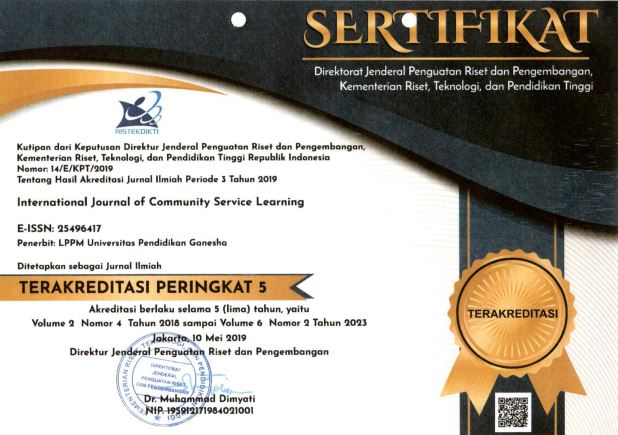Lymphatic Filariasis Control: School-based One Health Initiative on The Usage of Local Plants as Alternative Mosquito Repellants in Timor Tengah Selatan, Nusa Tenggara Timur
DOI:
https://doi.org/10.23887/ijcsl.v6i2.33887Keywords:
Lymphatic Filariasis, Mosquito Repellant, Local plants, TimorAbstract
Lymphatic filariasis is a mosquito-borne disease that poses a serious public health concern. The disease has spread to 28 Indonesian provinces, with NTT province being one of the 10 provinces with the highest incidence. Aside from being a major supporter of the annual mass drug administration program, the mosquito control initiative is also critical to the disease's eradication. However, today's mosquito control approaches depend primarily on synthetic moieties, which, unfortunately, have resulted in environmental problems and also resistance in important mosquito species. Consequently, developing alternative mosquito control strategies based on herbal components that are environmentally friendly, safe, and long-lasting is necessary. This one-health program aims to educate and raise public awareness of the importance of mosquito control and to inspire the community to utilize local plants as alternative mosquito repellents. This program is targeted high school students from the Timor Tengah Selatan regency. This regency is one of the NTT regencies with the highest risk of lymphatic filariasis. The approach method employed in this program was a series of presentations, discussions, and a demonstration of lymphatic filariasis and the selection of local plants that can be used as herbal repellents. Based on discussions with the students, it was discovered that after engaging in this activity, the participants had learned and recognized the dual function of various indigenous plants in their area as effective and cost-effective mosquito repellents. Furthermore, the students became more excited to learn and develop knowledge about the function of other local plants as efficient mosquito repellents.
References
Amer, A., & Mehlhorn, H. (2006). Repellency effect of forty-one essential oils against Aedes, Anopheles, and Culex mosquitoes. Parasitology Research, 99(4), 478–490. https://doi.org/10.1007/s00436-006-0184-1. DOI: https://doi.org/10.1007/s00436-006-0184-1
Amusan, A., Idowu, A., & Arowolo, F. (2005). Comparative toxicity effect of bush tea leaves (Hyptis suaveolens) and orange peel (Citrus sinensis) oil extract on larvae of the yellow fever mosquito Aedes aegypti. Tanzania Journal of Health Research, 7(3), 174–178. https://doi.org/10.4314/thrb.v7i3.14256. DOI: https://doi.org/10.4314/thrb.v7i3.14256
Anees, A. M. (2008). Larvicidal activity of Ocimum sanctum Linn. (Labiatae) against Aedes aegypti (L.) and Culex. Parasitology Research, 103(6), 1451–1453. https://doi.org/10.1007/s00436-008-0991-7. DOI: https://doi.org/10.1007/s00436-008-0991-7
Babu, S., & Nutman, T. B. (2014). Immunology of lymphatic filariasis. Parasite Immunology, 36(8), 338–346. https://doi.org/10.1111/pim.12081. DOI: https://doi.org/10.1111/pim.12081
Bockarie, M. J., Pedersen, E. M., White, G. B., & Michael, E. (2009). Role of Vector Control in the Global Program to Eliminate Lymphatic Filariasis. Annual Review of Entomology, 54(1), 469–487. https://doi.org/10.1146/annurev.ento.54.110807.090626. DOI: https://doi.org/10.1146/annurev.ento.54.110807.090626
Cassidy, T., Worrell, C. M., Little, K., Prakash, A., Patra, I., Rout, J., & Fox, L. M. (2016). Experiences of a Community-Based Lymphedema Management Program for Lymphatic Filariasis in Odisha State, India: An Analysis of Focus Group Discussions with Patients, Families, Community Members and Program Volunteers. PLoS Neglected Tropical Diseases, 10(2), e0004424. https://doi.org/10.1371/journal.pntd.0004424. DOI: https://doi.org/10.1371/journal.pntd.0004424
Cox, C. (2005). Plant-based mosquito repellents: making a careful choice. Journal of Pesticides Reform, 25(3), 6–7. https://www.panna.org/sites/default/files/mosquito-repellants.pdf
Das, N., Baruah, I., Talukdar, P., & Das, S. (2003). Evaluation of botanicals as repellents against mosquitoes. Journal of Vector Borne Diseases, 40(1/2), 49. http://www.mrcindia.org/journal/issues/401049.pdf.
Diop, S. M., Guèye, M. T., Ndiaye, I., Diop, M. B., Thiam, A., Fauconnier, M.-L., & Lognay, G. (2017). Study of the chemical composition of essential oils and floral waters of Cymbopogon citratus (DC.) Stapf (Poaceae) from Senegal. International Journal of Biological and Chemical Sciences, 11(4), 1884–1892. https://doi.org/10.4314/ijbcs.v11i4.37. DOI: https://doi.org/10.4314/ijbcs.v11i4.37
Gbolade, A., & Lockwood, G. (2008). Toxicity of Ocimum sanctum L. essential oil to Aedes aegypti larvae and its chemical composition. Journal of Essential Oil Bearing Plants, 11(2), 148–153. https://doi.org/10.1080/0972060X.2008.10643611. DOI: https://doi.org/10.1080/0972060X.2008.10643611
Gelolodo, M. A., Almet, J., & Detha, A. I. R. (2021). Upaya Penguatan Kesehatan Masyarakat: Edukasi tentang Penyakit Kaki Gajah (Filariasis Limfatik) di SMA Negeri 1 Amanuban Tengah, Kabupaten Timor Tengah Selatan. Media Tropika: Jurnal Pengabdian Masyarakat, 1(1), 1–15. https://ejurnal.undana.ac.id/index.php/mediatropika/article/view/3943.
Hendryani, A. (2019). Pengembangan Aplikasi Mobile Maintenance Untuk Mendukung Pemeliharaan Terencana Pada Alat Radiologi. Prosiding Seminar Nasional Kesehatan Poltekkes Kemenkes Surabaya, 110–115. http://semnas.poltekkesdepkes-sby.ac.id/index.php/2019/article/view/152.
Hossain, M. J., & Rahman, S. M. A. (2021). Repurposing therapeutic agents against SARS-CoV-2 infection: most promising and neoteric progress. In Expert Review of Anti-Infective Therapy (Vol. 19, Issue 8). https://doi.org/10.1080/14787210.2021.1864327. DOI: https://doi.org/10.1080/14787210.2021.1864327
Husna, I., Setyaningrum, E., Handayani, T. T., Kurnia, Y., Palupi, E. K., Umam, R., & Andriana, B. B. (2020). Utilization of Basil Leaf Extract as Anti-Mosquito Repellent: A Case Study of Total Mosquito Mortality (Aedes aegypti 3rd Instar). Paper Presented at the Journal of Physics: Conference Series, 467(1), 012014. https://doi.org/10.17509/ijost.v5i3.25370. DOI: https://doi.org/10.1088/1742-6596/1467/1/012014
Kalu, I., Ofoegbu, U., Eroegbusi, J., Nwachukwu, C., & Ibeh, B. (2010). Larvicidal activities of ethanol extract of Allium sativum (garlic bulb) against the filarial vector, Culex quinquefasciatus. Journal of Medicinal Plants Research, 4(6), 496–498. https://doi.org/10.5897/JMPR09.173.
Komoreng, L., Thekisoe, O., Lehasa, S., Tiwani, T., Mzizi, N., & Mokoena, N. (2017). An ethnobotanical survey of traditional medicinal plants used against lymphatic filariasis in South Africa. South African Journal of Botany, 111, 12–16. https://doi.org/10.1016/j.sajb.2017.03.005. DOI: https://doi.org/10.1016/j.sajb.2017.03.005
Kouassi, B. L., Barry, A., Heitz-Tokpa, K., Krauth, S. J., Goépogui, A., Baldé, M. S., & Utzinger, J. (2018). Perceptions, knowledge, attitudes and practices for the prevention and control of lymphatic filariasis in Conakry, Republic of Guinea. Acta Tropica, 179, 109–116. https://doi.org/10.1016/j.actatropica.2017.12.002. DOI: https://doi.org/10.1016/j.actatropica.2017.12.002
Kovendan, K., Murugan, K., Vincent, S., & Kamalakannan, S. (2011). Larvicidal efficacy of Jatropha curcas and bacterial insecticide, Bacillus thuringiensis, against lymphatic filarial vector, Culex quinquefasciatus Say (Diptera: Culicidae). Parasitology Research, 109(5), 1251–1257. https://doi.org/10.1007/s00436-011-2368-6. DOI: https://doi.org/10.1007/s00436-011-2368-6
Masuda, T., Odaka, Y., Ogawa, N., Nakamoto, K., & Kuninaga, H. (2008). Identification of geranic acid, a tyrosinase inhibitor in lemongrass (Cymbopogon citratus). Journal of Agricultural and Food Chemistry, 56(2), 597–601. https://doi.org/10.1021/jf072893l. DOI: https://doi.org/10.1021/jf072893l
Mathew, N. (2017). Mosquito repellent activity of volatile oils from selected aromatic plants. Parasitology Research, 116(2), 821–825. https://doi.org/10.1007/s00436-016-5351-4 DOI: https://doi.org/10.1007/s00436-016-5351-4
Michael, E., Malecela-Lazaro, M. N., Simonsen, P. E., Pedersen, E. M., Barker, G., Kumar, A., & Kazura, J. W. (2004). Mathematical modelling and the control of lymphatic filariasis. The Lancet Infectious Diseases, 4(4), 223–234. https://doi.org/10.1016/S1473-3099(04)00973-9. DOI: https://doi.org/10.1016/S1473-3099(04)00973-9
Murugan, K., Kumar, P. M., Kovendan, K., Amerasan, D., Subrmaniam, J., & Hwang, J.-S. (2012). Larvicidal, pupicidal, repellent and adulticidal activity of Citrus sinensis orange peel extract against Anopheles stephensi, Aedes aegypti and Culex quinquefasciatus (Diptera: Culicidae). Parasitology Research, 111(4), 1757–1769. https://doi.org/10.1007/s00436-012-3021-8. DOI: https://doi.org/10.1007/s00436-012-3021-8
Ottesen, E. A. (2006). Lymphatic filariasis: treatment, control and elimination. Advances in Parasitology, 61, 395–441. https://doi.org/10.1016/S0065-308X(05)61010-X. DOI: https://doi.org/10.1016/S0065-308X(05)61010-X
Phasomkusolsil, S., & Soonwera, M. (2010). Insect repellent activity of medicinal plant oils against Aedes aegypti (Linn.), Anopheles minimus (Theobald) and Culex quinquefasciatus Say based on protection time and biting rate. Southeast Asian J Trop Med Public Health, 41(4), 831–840. https://www.thaiscience.info/Journals/Article/TMPH/10897805.pdf.
Rajkumar, S., & Jebanesan, A. (2009). Larvicidal and oviposition activity of Cassia obtusifolia Linn (Family: Leguminosae) leaf extract against malarial vector, Anopheles stephensi Liston (Diptera: Culicidae). Parasitology Research, 104(2), 337–340. https://doi.org/10.1007/s00436-008-1197-8. DOI: https://doi.org/10.1007/s00436-008-1197-8
Rebollo, M. P., & Bockarie, M. J. (2014). Shrinking the lymphatic filariasis map: update on diagnostic tools for mapping and transmission monitoring. Parasitology, 141(14), 1912–1917. https://doi.org/10.1017/s0031182014001231. DOI: https://doi.org/10.1017/S0031182014001231
Rebollo, M. P., & Bockarie, M. J. (2017). Can Lymphatic Filariasis Be Eliminated by 2020? Trends in Parasitology, 33(2), 83–92. https://doi.org/10.1016/j.pt.2016.09.009. DOI: https://doi.org/10.1016/j.pt.2016.09.009
Sato, M., Goto, M., & Hirose, T. (1996). Supercritical fluid extraction on semibatch mode for the removal of terpene in citrus oil. Industrial & Engineering Chemistry Research, 35(6), 1906–1911. https://doi.org/10.1021/ie9505773. DOI: https://doi.org/10.1021/ie9505773
Shukla, D., Wijayapala, S., & Vankar, P. S. (2018). Effective mosquito repellent from plant based formulation. International Journal of Mosquito Research, 5(1), 19–24. https://www.dipterajournal.com/pdf/2018/vol5issue1/PartA/4-6-17-974.pdf.
Singh, D. K., & Singh, V. K. (2008). Pharmacological Effects of Allium Sativum L.(Garlic. Annual Review of Biomedical Sciences. Annual Review of Biomedical Sciences, 10, 6–26. https://arbs.biblioteca.unesp.br/index.php/arbs/article/view/102. DOI: https://doi.org/10.5016/1806-8774.2008.v10p6
Singh, S., Mahour, K., & Prakash, S. (2009). Evaluation of mosquito repellent efficacy of Ocimum sanctum plant extract. Journal of Herbal Medicine and Toxicology, 3(1), 87–90. http://citeseerx.ist.psu.edu/viewdoc/download?doi=10.1.1.469.2326&rep=rep1&type=pdf.
Soonwera, M., & Phasomkusolsil, S. (2015). Efficacy of Thai herbal essential oils as green repellent against mosquito vectors. Acta Trop, 142, 127–130. https://doi.org/10.1016/j.actatropica.2014.11.010. DOI: https://doi.org/10.1016/j.actatropica.2014.11.010
Sritabutra, D., & Soonwera, M. (2013). Repellent activity of herbal essential oils against Aedes aegypti (Linn.) and Culex quinquefasciatus (Say.). Asian Pacific Journal of Tropical Disease, 3(4), 271–276. https://doi.org/10.1016/S2222-1808(13)60069-9. DOI: https://doi.org/10.1016/S2222-1808(13)60069-9
Sritabutra, D., Soonwera, M., Waltanachanobon, S., & Poungjai, S. (2011). Evaluation of herbal essential oil as repellents against Aedes aegypti (L.) and Anopheles dirus Peyton & Harrion. Asian Pacific Journal of Tropical Biomedicine, 1(1), S124-S128. https://doi.org/10.1016/S2221-1691(11)60138-X. DOI: https://doi.org/10.1016/S2221-1691(11)60138-X
Tisgratog, R., Sanguanpong, U., Grieco, J. P., Ngoen-Kluan, R., & Chareonviriyaphap, T. (2016). Plants traditionally used as mosquito repellents and the implication for their use in vector control. Acta Tropica, 157, 136–144. https://doi.org/10.1016/j.actatropica.2016.01.024. DOI: https://doi.org/10.1016/j.actatropica.2016.01.024
Verma, S. (2016). Chemical constituents and pharmacological action of Ocimum sanctum (Indian holy basil-Tulsi). The Journal of Phytopharmacology, 5(5), 205–207. http://www.phytopharmajournal.com/Vol5_Issue5_07.pdf. DOI: https://doi.org/10.31254/phyto.2016.5507
Warikoo, R., Ray, A., Sandhu, J. K., Samal, R., Wahab, N., & Kumar, S. (2012). Larvicidal and irritant activities of hexane leaf extracts of Citrus sinensis against dengue vector Aedes aegypti L. Asian Pacific Journal of Tropical Biomedicine, 2(2), 152–155. https://doi.org/10.1016/S2221-1691(11)60211-6. DOI: https://doi.org/10.1016/S2221-1691(11)60211-6
Wynd, S., Melrose, W. D., Durrheim, D. N., Carron, J., & Gyapong, M. (2007). Understanding the community impact of lymphatic filariasis: a review of the sociocultural literature. ,. Bulletin of the World Health Organization, 85, 493–498. https://www.scielosp.org/article/ssm/content/raw/?resource_ssm_path=/media/assets/bwho/v85n6/a17v85n6.pdf. DOI: https://doi.org/10.2471/BLT.06.031047
Yunarko, R., & Patanduk, Y. (2016). Distribusi Filariasis Brugia Timori dan Wuchereria Bancrofti di Desa Kahale, Kecamatan Kodi Balaghar, Kabupaten Sumba Barat Daya, Nusa Tenggara Timur. Balaba: Jurnal Litbang Pengendalian Penyakit Bersumber Binatang Banjarnegara, 2(2), 89-98. doi:https://d. Balaba: Jurnal Lıtbang Pengendalıan Penyakıt Bersumber Bınatang Banjarnegara, 2(2), 89–98. https://doi.org/10.22435/blb.v12i2.202. DOI: https://doi.org/10.22435/blb.v12i2.202
Zeldenryk, L. M., Gray, M., Speare, R., Gordon, S., & Melrose, W. (2011). The emerging story of disability associated with lymphatic filariasis: a critical review. PLoS Neglected Tropical Diseases, 5(12), e1366. https://doi.org/10.1371/journal.pntd.0001366. DOI: https://doi.org/10.1371/journal.pntd.0001366
Downloads
Published
How to Cite
Issue
Section
License
Copyright (c) 2022 International Journal of Community Service Learning

This work is licensed under a Creative Commons Attribution-ShareAlike 4.0 International License.

International Journal of Comunnity Service Learning is licensed under a Creative Commons Attribution-ShareAlike 4.0 International License.













